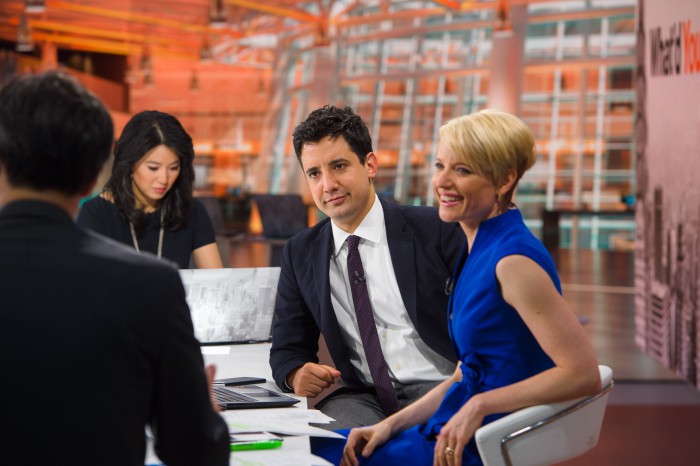
Bloomberg has done well expanding the reach of its online video offerings. After a revamp of its website, which includes a Bloomberg TV video player locked in at the top right of the navigation bar, its unique video visitors have gotten a big bump, recording 15.9 million unique visitors to video in September, by latest comScore measures. (“If digital video isn’t core to what you’re doing, that’s crazy to me,” Bloomberg’s then–top digital editor Joshua Topolsky told Nieman Lab earlier this year.)

“At Bloomberg, we’re trying to really nail the multi-platform opportunity,” Weisenthal said. “We have TV, we have the web, we have online video, which we invest a lot in, and we see TV, in large part, to be a source of content for online video.”
I spoke with Weisenthal about TV guests, social media, taking finance journalism beyond a wonky following, and podcasts. Below is a lightly condensed and edited version of our conversation.
While I was in London a few weeks ago, I spoke with a hedge fund manager there named Toby Nangle, who has a very distinct idea: he bases his investing, in part, on a big theory he has about changing global demographics. He’s done some original research on how demographic changes are going to change the global economy, and he adjusted his portfolio.
If you look at a typical Wall Street interview, it might just be some strategist who recommends some stocks, and the stocks are kind of boring, or he’s talking up his book or something like that. I really like talking to someone with a distinct view, distinct research, a distinct call that will really stand out.
One of my favorite guests so far has been Lord Robert Skidelsky. He’s a member of the House of Lords, and he is also the most famous biographer of John Maynard Keynes, so talking to him is the closest thing we have to talking to the most legendary economist — he kind of channels Keynes.
Robert Skidelsky says Keynes wouldn't have liked how QE is distorting the economy. http://t.co/xwsSg7CbPK pic.twitter.com/ftNgjSVC5J
— Joseph Weisenthal (@TheStalwart) August 13, 2015
So we have this brilliant thinker, and we can talk to him about the events of the day, such as what is the perspective on what’s going on in China, or the latest developments in monetary policy. It’s a great intersection of timely news stories with someone with a very distinct point of view, who really stands out from the other people talking about these subjects.
So when I think about who the ideal audience for the show is, or what’s the reaction that I want the show to have, or who do I want to like the show — it’s a lot of the people who’ve been commenting and talking on social media and blogs for a long time. That’s a big point of what we try to accomplish, getting our segment to resonate with those people.
I get a lot of good feedback. I see people responding to the show in real time. I get a lot of emails from people while I’m on the air, saying, ‘You should ask this question,’ and I may do it.
This is one of the nice things about having Bloomberg Terminal and the whole network of people on the terminal who we can communicate with while we’re on the show. When I think about the show, I’m thinking less about the standard linear TV viewer, and more about how it’s going to play on multiple platforms, how it’s going to play on social.
We use the terminal aggressively throughout the show. We go into the terminal quite a lot, in order to demonstrate all the data, the charting capabilities that it has. So we’re constantly drawing on the resources of Bloomberg News. That’s one of the things that helps the show stand out.
We have the terminal set up so that any one of us can pull up a chart during the show and put it up on the whole screen and display it to the audience, really making the conversation come alive.
Speaking of social media, I’ve found a lot of our guests from the people I’ve followed on social media for a long time. I noticed that there was a gap between, say, a person online who I really loved reading because they’re super smart about housing, or they’re super smart about interest rates, and then the same old guests on TV, that no one was really paying attention to.
When I started getting into TV, I said, why don’t we have all those people I follow online, who are smart about certain subjects, come on the show? And now some of them have come on multiple times. Those segments resonate because our audience knows those people; they represent a fresh voice.
I knew a lot of people on Wall Street were reading him, and he was just so good and so knowledgeable. But I could never understand why he wasn’t the go-to housing market analyst for all the media around the world! Why wasn’t he on TV every week? He really knew his stuff, and he was willing to change his mind as the facts changed — which is what you want from a pundit, so that they’re not just one single view.
We’ve had him on a couple of times now. There are so many opportunities like that, and I’d like us to do more like that on the show.
I think there’s an opportunity at Bloomberg, speaking of Business Insider. One of the things Business Insider does really well is that their social travels around the web fast, and they make a lot of stories accessible. There’s a lot more we can do in that regard.
On the other hand, Bloomberg can offer unparalleled sophistication because of how much data we have and how knowledgeable our writers and editors are about these specific topics. There’s an opportunity to marry those two things, where you get really good at the distribution, and really good at drawing people in who maybe didn’t think they were fans of business news, while also offering the most sophisticated analysis and reporting around. I think everyone can work on doing either side better. It’s not something missing, per se, it’s just an endless pursuit of these goals.
I don’t feel any pressure on the digital or TV side to get more viewers by dumbing down the content or being cheesy. There’s definitely no pressure to get readers or viewers just for numbers’ sake. But, of course, we want more people to consume our stuff, so we try to do it really well and put it on platforms where people are consuming content on.
It’s the ultimate “snackable” piece of content. It’s fun, people like to share it, but it’s also really sophisticated because we can dive into the data and show something really interesting in the terminal that other people don’t have.
There’s no compromise where we turn down the quality or turn down the sophistication to go viral. Because we have all these resources and data, we can keep the sophistication really high, and also go viral and be snackable, as they say.
Coming from the TV show perspective, our show is long, but sometimes you just wish you could talk to someone forever. I’m looking forward to the podcast as a opportunity to, once a week, have an in-depth conversation with someone really fascinating. It’ll be on a range of topics, from markets to finance to economics. Tracy and I have eclectic interests, so I’m looking forward to experimenting in that medium.
I would not be surprised if we had topics that were even further afield from breaking news. Someone who has a very obscure, wonky, interest in something that’s not necessarily part of the day’s or week’s news cycle — maybe they’ve done some research into an area — that will be something the podcast is good for.
A lot of people like to consume news and other information via podcasts. I like listening to them, too. So I think it’ll be fun.